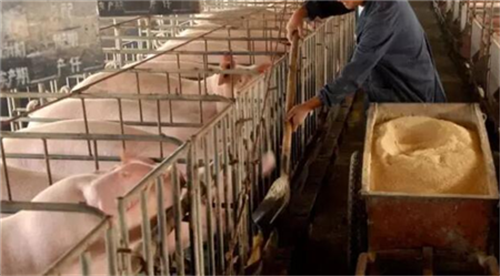Clinical diagnosis and treatment of common reproductive disorders in small and medium-sized pig farms (2)
The autopsy of the case showed meningeal hemorrhage, edema and excessive amount of cerebrospinal fluid in dead piglets; gray-white necrotic spots in liver, spleen and other parenchyma organs, necrotic foci in kidneys, red halos around them, yellow-white or gray-white in the center, and extremely bright red-yellow necrotic foci in the brown background of the liver. Abortions and stillbirths are of the same size, with varying degrees of softening, and there are a large amount of brown retention fluid in chest, abdominal cavity and pericardium. Intrauterine infection in sows can develop into lytic necrotizing placentitis.
2.3 Porcine circovirus disease
The main manifestations of porcine circovirus disease of reproductive disorders were increased body temperature to 41 ℃ ~ 42 ℃, loss of appetite, abortion, stillbirth, weak and mummified fetus, respiratory organ disorders characterized by dyspnea and cough, skin and visual mucosal jaundice, dysentery and drowsiness in some cases, and piglets infected with the disease showed congenital tremor in piglets and multisystemic failure syndrome in weaned pigs. The conception rate of sows is low or infertile after the disease, and the mortality rate of piglets before weaning increases by more than 10%.

There were no obvious pathological changes in congenital tremor, necrotizing or fibrous myocarditis in weaned piglets with multiple system failure syndrome, anthrax, pulmonary atrophy and interstitial pneumonia in some pigs, enlargement and pallor of kidney, atrophy of liver to a certain extent, hyperemia, hemorrhage and edema in body surface and mesenteric lymph nodes. Postmortem examination showed stillbirth and mummified fetus, hydrothorax and abdomen, dilated heart, flabby, pallor, and congestive heart failure.
2.4 Porcine parvovirus disease
When pregnant sows are infected in the first trimester, it causes miscarriage and embryo death. When early embryos are infected, the mortality rate can reach 80% to 100%, and is quickly absorbed by the mother, resulting in infertility and repeated estrus. Infection in the middle and later stages of pregnancy often forms mummified fetuses to varying degrees, which are excreted during normal delivery, accounting for an average of about 10% of the number of pigs delivered. Generally speaking, after 70 days of pregnancy, most fetuses can survive with a meaningful immune response to viral infection, but these piglets often carry antibodies and viruses. Other kinds of pigs have no obvious clinical symptoms after infection.
The main pathological changes were mild endometritis, partial calcification of placenta, dissolution of fetus in uterus, tissue softening and absorption. Hyperemia, edema, bleeding, body cavity effusion, dehydration, mummification and other pathological changes can be seen in infected fetus. The weak piglets appeared congestion and bleeding spots on the tip of the ear, neck, chest, abdomen and upper extremities about half an hour after birth, and all the skin turned purple and died within half a day. Autopsy sometimes shows enlargement, weakness or atrophy of liver, spleen and kidney.
2.5 mild classical swine fever
In recent years, mild classical swine fever or atypical classical swine fever is the main form of classical swine fever, which is characterized by reproductive disorders of sows, abortion, premature delivery, stillbirth or mummified fetus, non-estrus or infertility, congenital infection of piglets, weakness after birth, loose stool, death one after another, severe death around 20 days old or before and after weaning, and occasionally congenital tremor.
The main pathological changes were systemic septicemia, extensive punctate bleeding in larynx, chest muscle, serosa, kidney and digestive tract, swelling, congestion, bleeding and purplish black appearance of systemic lymph nodes, swelling, flushing, bleeding and marble section of kidney, hemorrhagic infarction on the edge of spleen, but generally not swollen, and scattered bleeding spots in small intestine, large intestine and bladder mucosa of some diseased pigs. Button ulcer can be seen in the colonic ileocecal valve of piglets, and the change of systemic bleeding is not obvious.
- Prev

Clinical diagnosis and treatment of common reproductive disorders in small and medium-sized pig farms (1)
Clinical diagnosis and treatment of common reproductive disorders in small and medium-sized pig farms (1)
- Next

Clinical diagnosis and treatment of common reproductive disorders in small and medium-sized pig farms (3)
Clinical diagnosis and treatment of common reproductive disorders in small and medium-sized pig farms (3)
Related
- On the eggshell is a badge full of pride. British Poultry Egg Market and Consumer observation
- British study: 72% of Britons are willing to buy native eggs raised by insects
- Guidelines for friendly egg production revised the increase of space in chicken sheds can not be forced to change feathers and lay eggs.
- Risk of delay in customs clearance Australia suspends lobster exports to China
- Pig semen-the Vector of virus Transmission (4)
- Pig semen-the Vector of virus Transmission (3)
- Five common causes of difficult control of classical swine fever in clinic and their countermeasures
- Foot-and-mouth disease is the most effective way to prevent it!
- PED is the number one killer of piglets and has to be guarded against in autumn and winter.
- What is "yellow fat pig"? Have you ever heard the pig collector talk about "yellow fat pig"?

